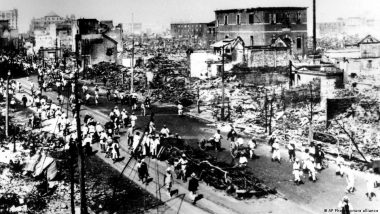Japan is marking 100 years since a devastating earthquake triggered a widespread inferno in Kanto, a region that includes the capital, Tokyo. Most of the tens of thousands of victims perished in the fire.Shortly before midday on Friday, Japan marked the 100th anniversary of the most destructive earthquake in the nation's modern history with solemn reminders that the next "big one" could strike the congested capital, Tokyo, at any moment.
Also Read | Great Kanto Quake: Is Japan Ready for the Next Big One?.
And while as many as 142,000 people died in the Great Kanto Earthquake and the fires that tore through Tokyo and Yokohama, experts here warn that the Japanese public is largely unprepared for another natural disaster that is simply inevitable.
Indeed, seismologists put the likelihood of another major quake beneath the Kanto region of Tokyo and the surrounding prefectures at 70% in the next 30 years.
Today, Kanto is home to about 43.3 million people and is the heartbeat of the Japanese economy. In contrast, the March 2011 quake and tsunami struck the far more sparsely populated northeastern part of the country, yet still left around 20,000 dead and an enormous and costly recovery project in its wake.
Megathrust tremor
The 1923 megathrust tremor struck with an estimated 7.9 magnitude and just 23 kilometers (14.3 miles) beneath the surface. Survivors' accounts indicated the shaking lasted up to 10 minutes, with landslides and a tsunami of up to 12 meters striking long stretches of coastline to the south of the capital. There were dozens of aftershocks over the following days.
Many of the deaths were attributed to fires that broke out in the congested back streets of Tokyo and Yokohama, where most houses were still made of wood. There are stories of people being caught in vortexes of fire when their feet became stuck in the melting tarmac of roads.
In 1960, September 1 was designated as Disaster Prevention Day and local governments carry out disaster drills involving the evacuation of buildings as well as exercises by volunteer firefighters and emergency medical teams.
Schools across the country also conduct emergency drills, along with many private companies.
Yet, despite the scale of the disaster — and a vivid reminder of the power that earthquakes can unleash just 12 years ago — many Japanese remain blasé about the danger they face.
What lessons have been learned?
Takako Tomura, a housewife from Yokohama, is not worried.
"We have some bottled water stored away and I try to keep some tins of food and others that can keep for a long time, but then I am too busy to go to the shop and I use some of the emergency stocks," she said. "The other problem is that our apartment is not very big, so it is difficult to keep a lot of emergency stocks.
"Obviously I hope we do not have a big earthquake, but if it happens we will just have to manage the best we can."
Yoshiaki Hisada, a professor who specializes in the study of earthquakes at Japan's Kogakuin University, said that Japan's cities are now much better prepared to withstand a major natural disaster than they were 100 years ago.
"Certainly many lessons have been learned. Seismic designs make buildings much safer and the construction regulations make even very tall buildings safe," he told DW.
"The problem is that there are still a lot of older buildings in very densely packed parts of the cities, where fires could easily spread and would be very difficult to extinguish."
Aware of the danger, the Tokyo metropolitan government announced earlier this month that it is stepping up efforts to redevelop all areas in the city that have wooden houses by the 2040s. At present, the city has some 8,600 hectares of old housing that is at greater risk in the event of a major natural disaster.
Thousands of deaths predicted in Tokyo
A study by the city released last year estimated that a magnitude-7.3 tremor directly beneath the city could cause over 6,000 fatalities and destroy or damage 194,400 buildings.
According to Hisada, the areas that are most at risk are in Arakawa Ward, which has a large number of older properties and is also susceptible to flooding in the event of a tsunami.
"We need to prepare better countermeasures and educate people about the problems they might face," he said.
Residents of one of the most densely populated conurbations on the planet need to know how to turn off gas lines and handle a fire extinguisher, experts stress. They need to know some basic first aid and how to respond when trapped in a tall building when the elevator no longer works or when doors no longer open because a structure is damaged.
They also need to prepare sufficient supplies of water and basic foodstuffs in their homes for the first few days after a disaster and be ready to help recovery efforts in their neighborhoods.
"People have to be ready and they will need to help each other, although I do not believe most have the experience or are sufficiently prepared for when an earthquake does happen," Hisada said. "They do not have the food supplies and they do not know how to help an injured person. It is worrying."
Many people are not ready
Hiromi Iuchi, who works for a company in Tokyo, admits that even with all the coverage of the 100th anniversary of the earthquake, she is not ready.
"In truth, I have not made any preparations," she said. "It's bothersome and perhaps I'm lazy, but my sister takes it all very seriously. She keeps telling our parents to be ready and she has used special fixtures so that the cupboards don't fall on them if there is an earthquake."
"My company has some precautions as well and every year they give us the packages of freeze-dried food that they keep for emergencies just before it expires and they buy new stocks," she said.
"I know people are worried about the next Big One, but I was not in Japan at that time so maybe I am not so conscious of how bad things can be."
Edited by: Srinivas Mazumdaru
(The above story first appeared on LatestLY on Sep 01, 2023 10:50 PM IST. For more news and updates on politics, world, sports, entertainment and lifestyle, log on to our website latestly.com).












 Quickly
Quickly




















